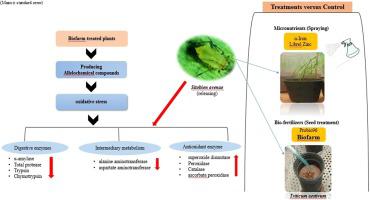Journal of Asia-Pacific Entomology ( IF 1.5 ) Pub Date : 2021-06-18 , DOI: 10.1016/j.aspen.2021.06.003 Maryam Pourya , Jahanshir Shakarami , Mozhgan Mardani-Talaee , Amin Sadeghi , Jose Eduardo Serrão

|
The English grain aphid, Sitobion avenae (Fabricius) (Hemiptera: Aphididae), is one of the most serious pests of cereals as the transmitter of viral diseases, mainly in wheat, Triticum aestivum. This agricultural pest is controlled with chemical insecticides, which is environmental pollutants and toxic for human. This study evaluated the potential of alternative environmentally friendly compounds to control this insect pest. The activities of digestive, antioxidants, and intermediary metabolism enzymes of S. avenae reared on wheat plants treated with bio-fertilizers (Biofarm and Probio96) and micronutrients (Librel Zinc and α-Iron) in the greenhouse were evaluated. The results reveal that α-amylase, total protease, trypsin, chymotrypsin, amino- and carboxypeptidases, alanine- and aspartate- aminotransferases, and acid phosphatase enzymes had lower activities in S. avenae reared on Biofarm treated plants compared to control. On the other hand, aphids reared on treated plants with Biofarm had the highest activities of antioxidant enzymes superoxide dismutase, catalase, peroxidase, and ascorbate oxidase, γ- glutamyl transferase, as well as lactate dehydrogenase. Moreover, the oxidized/reduced thiols ratio and malondialdehyde indicated higher activity in the aphids reared on Biofarm-treated plants than control. These results suggest that the bio-fertilizer Biofarm may compromise the physiology of S. avenae as a potential alternative toll in the integrated pest management of this aphid.
中文翻译:

生物肥料和微量营养素影响温室中英国粮食蚜虫 Sitobion avenae 的消化率、解毒和中间代谢
英国粮食蚜虫Sitobion avenae(Fabricius)(半翅目:Aphididae)是谷物最严重的害虫之一,是病毒病的传播者,主要分布于小麦、小麦(Triticum aestivum)。这种农业害虫是用化学杀虫剂控制的,化学杀虫剂是环境污染物,对人类有毒。这项研究评估了替代环保化合物控制这种害虫的潜力。燕麦的消化酶、抗氧化剂和中间代谢酶的活性评估了在温室中用生物肥料(Biofarm 和 Probio96)和微量营养素(Librel Zinc 和 α-Iron)处理的小麦植株上饲养的小麦。结果表明,α-淀粉酶、总蛋白酶、胰蛋白酶、胰凝乳蛋白酶、氨基和羧肽酶、丙氨酸和天冬氨酸氨基转移酶以及酸性磷酸酶在燕麦中的活性较低与对照相比,在 Biofarm 处理的植物上饲养。另一方面,在经过 Biofarm 处理的植物上饲养的蚜虫的抗氧化酶超氧化物歧化酶、过氧化氢酶、过氧化物酶和抗坏血酸氧化酶、γ-谷氨酰转移酶以及乳酸脱氢酶的活性最高。此外,氧化/还原硫醇比和丙二醛表明在 Biofarm 处理的植物上饲养的蚜虫比对照具有更高的活性。这些结果表明,生物肥料 Biofarm 可能会损害S. avenae的生理机能,作为这种蚜虫综合害虫管理的潜在替代方法。



























 京公网安备 11010802027423号
京公网安备 11010802027423号